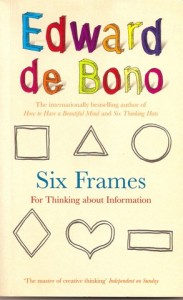The one-sentence summary
Discipline your business thinking, and the way in which you organise information.
- In a world saturated with facts and figures as never before, how do we focus our attention to make the most of information at our fingertips?
- The book suggests a ‘six frames’ technique to help direct our attention in a conscious manner, rather than always letting it be pulled to the unusual and irrelevant.
- Just as we can decide to look north, west or even south-east, so we can set up a framework for directing our attention and interpreting information
- The six frames are:
Purpose: the triangle frame. To emphasise the huge importance of being clear and laying out the exact basis of your need for information
Accuracy: The circle frame. To direct your attention specifically to the accuracy of the information at which you are looking
Point of View: the square frame. To assess the information for neutrality and look at it in different ways
Interest: the heart frame. To direct attention to matters of interest rather than the pure need for information
Value: the diamond frame. A summary or overview that determines the value of the information
Outcome: the slab frame. The outcome and conclusion. Not everyone faced with the same information comes to the same conclusion
WHAT’S GOOD ABOUT IT
- We cannot live without information and we are surrounded by it. But it can often become overwhelming to the point where it loses its usefulness. Companies and individuals who are in this position would do well to clarify and simplify it long these lines
- The big enemy of good thinking is confusion, which becomes more likely the more active the mind. Clarity is good, but not at the expense of comprehensiveness. The main cause of confusion is trying to do everything at once. The system makes this an orderly process
WHAT YOU HAVE TO WATCH
- The book is short and simple, but it should not be applied simplistically

